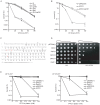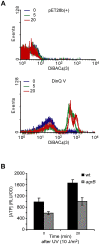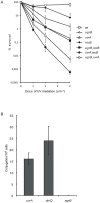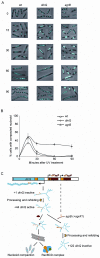Single transmembrane peptide DinQ modulates membrane-dependent activities
- PMID: 23408903
- PMCID: PMC3567139
- DOI: 10.1371/journal.pgen.1003260
Single transmembrane peptide DinQ modulates membrane-dependent activities
Abstract
The functions of several SOS regulated genes in Escherichia coli are still unknown, including dinQ. In this work we characterize dinQ and two small RNAs, agrA and agrB, with antisense complementarity to dinQ. Northern analysis revealed five dinQ transcripts, but only one transcript (+44) is actively translated. The +44 dinQ transcript translates into a toxic single transmembrane peptide localized in the inner membrane. AgrB regulates dinQ RNA by RNA interference to counteract DinQ toxicity. Thus the dinQ-agr locus shows the classical features of a type I TA system and has many similarities to the tisB-istR locus. DinQ overexpression depolarizes the cell membrane and decreases the intracellular ATP concentration, demonstrating that DinQ can modulate membrane-dependent processes. Augmented DinQ strongly inhibits marker transfer by Hfr conjugation, indicating a role in recombination. Furthermore, DinQ affects transformation of nucleoid morphology in response to UV damage. We hypothesize that DinQ is a transmembrane peptide that modulates membrane-dependent activities such as nucleoid compaction and recombination.
Conflict of interest statement
The authors have declared that no competing interests exist.
Figures

 ) and stop (
) and stop ( ) for dinQ, agrA and agrB. AgrAB repeat sequences are shadowed. (C) Alignment of agrA/agrB sequences antisense to dinQ. The agrAB repeat of dinQ is antisense to sequences in the agrA and agrB transcripts.
) for dinQ, agrA and agrB. AgrAB repeat sequences are shadowed. (C) Alignment of agrA/agrB sequences antisense to dinQ. The agrAB repeat of dinQ is antisense to sequences in the agrA and agrB transcripts.





Similar articles
-
Mutually exclusive RNA secondary structures regulate translation initiation of DinQ in Escherichia coli.RNA. 2016 Nov;22(11):1739-1749. doi: 10.1261/rna.058461.116. Epub 2016 Sep 20. RNA. 2016. PMID: 27651528 Free PMC article.
-
The small RNA IstR inhibits synthesis of an SOS-induced toxic peptide.Curr Biol. 2004 Dec 29;14(24):2271-6. doi: 10.1016/j.cub.2004.12.003. Curr Biol. 2004. PMID: 15620655
-
A small SOS-induced toxin is targeted against the inner membrane in Escherichia coli.Mol Microbiol. 2008 Oct;70(1):258-70. doi: 10.1111/j.1365-2958.2008.06416.x. Epub 2008 Aug 29. Mol Microbiol. 2008. PMID: 18761622
-
MicF: an antisense RNA gene involved in response of Escherichia coli to global stress factors.J Mol Biol. 2001 Oct 12;313(1):1-12. doi: 10.1006/jmbi.2001.5029. J Mol Biol. 2001. PMID: 11601842 Review.
-
Is the cellular and molecular machinery docile in the stationary phase of Escherichia coli?Biochem Soc Trans. 2015 Apr;43(2):168-71. doi: 10.1042/BST20140267. Biochem Soc Trans. 2015. PMID: 25849912 Review.
Cited by
-
Type I toxin-dependent generation of superoxide affects the persister life cycle of Escherichia coli.Sci Rep. 2019 Oct 3;9(1):14256. doi: 10.1038/s41598-019-50668-1. Sci Rep. 2019. PMID: 31582786 Free PMC article.
-
Escherichia coli type I toxin TisB exclusively controls proton depolarization following antibiotic induced DNA damage.Sci Rep. 2025 Apr 14;15(1):12774. doi: 10.1038/s41598-025-96136-x. Sci Rep. 2025. PMID: 40229382 Free PMC article.
-
Effect of subinhibitory exposure to quaternary ammonium compounds on the ciprofloxacin susceptibility of Escherichia coli strains in animal husbandry.BMC Microbiol. 2020 Jun 11;20(1):155. doi: 10.1186/s12866-020-01818-3. BMC Microbiol. 2020. PMID: 32527225 Free PMC article.
-
In Vitro Characterization of the Type I Toxin-Antitoxin System bsrE/SR5 from Bacillus subtilis.J Biol Chem. 2016 Jan 8;291(2):560-71. doi: 10.1074/jbc.M115.697524. Epub 2015 Nov 12. J Biol Chem. 2016. PMID: 26565032 Free PMC article.
-
Stress-Induced Mutagenesis, Gambler Cells, and Stealth Targeting Antibiotic-Induced Evolution.mBio. 2022 Jun 28;13(3):e0107422. doi: 10.1128/mbio.01074-22. Epub 2022 Jun 6. mBio. 2022. PMID: 35658528 Free PMC article. Review.
References
-
- Fernandez De Henestrosa AR, Ogi T, Aoyagi S, Chafin D, Hayes JJ, Ohmori H, et al. (2000) Identification of additional genes belonging to the LexA regulon in Escherichia coli. Mol Microbiol 35: 1560–1572. - PubMed
-
- Zuber P (2001) A peptide profile of the Bacillus subtilis genome. Peptides 22: 1555–1577 doi:DOI:10.1016/S0196-9781(01)00492-2. - DOI - PubMed
-
- Ibrahim M, Nicolas P, Bessieres P, Bolotin A, Monnet V, et al. (2007) A genome-wide survey of short coding sequences in streptococci. Microbiology 153: 3631–3644. - PubMed
-
- Alix E, Blanc-Potard ABa (2009) Hydrophobic peptides: novel regulators within bacterial membrane. Mol Microbiol 72: 5–1110.1111/j.1365-2958.2009.06626.x. - PubMed
Publication types
MeSH terms
Substances
LinkOut - more resources
Full Text Sources
Other Literature Sources
Molecular Biology Databases

